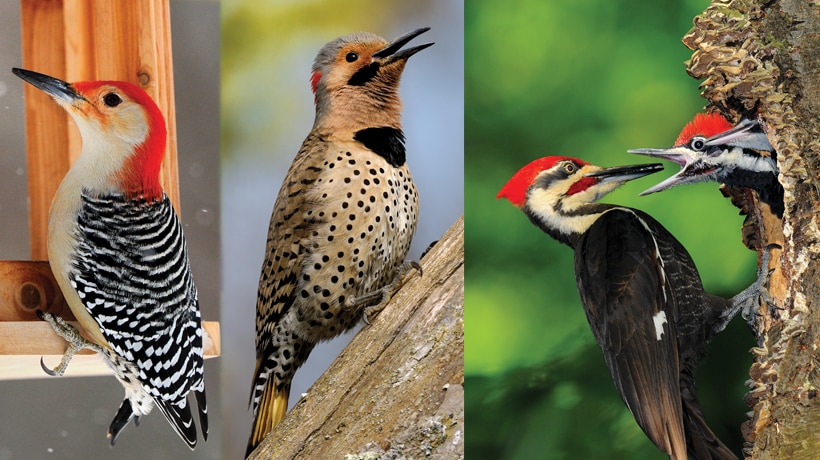Revealing the Keys of Woodpeckers: Actions, Environment, and A Lot More
Woodpeckers, with their unique behaviors and specialized adaptations, have actually lengthy attracted researchers and nature enthusiasts alike. These remarkable birds possess an array of interesting tricks that shed light on their survival strategies, habitat preferences, and complex communication methods. By revealing the mysteries surrounding woodpeckers' behavior and habitat selections, a deeper understanding of these avian wonders arises, supplying a peek right into their remarkable world. So, what makes these birds really phenomenal, and exactly how do they browse their atmosphere with such precision and ability? Allow's explore the captivating world of woodpeckers and decipher the enigmatic information that make them such fascinating topics of research study.
Woodpecker Behavior Insights
In checking out woodpecker actions, an interesting display of specialized abilities and adaptations arises, dropping light on their impressive ecological specific niche. Woodpeckers, understood for their distinctive drumming on trees, possess a selection of behavior traits that add to their survival and success in their atmosphere.
Furthermore, woodpeckers show an one-of-a-kind feeding habits identified by their capability to remove insects from tree bark utilizing their specialized beaks. Their lengthy, barbed tongues aid in recording target, while their solid neck muscles provide security and precision during pecking motions. This feeding approach permits woodpeckers to gain access to surprise insect larvae and extract them with exceptional efficiency.
Habitat Preferences and Choice
What aspects influence the habitat choices and choice of woodpeckers? One critical variable influencing woodpecker habitat option is the accessibility of suitable nesting websites. Woodpeckers commonly prefer woodlands with a mix of mature trees that offer enough chances for cavity excavation.
Additionally, woodpeckers reveal a preference for environments with a plentiful supply of food sources. They are primarily insectivorous, feeding upon beetles, ants, larvae, and other bugs located in worn out timber or tree bark. Consequently, woodpeckers often tend to prefer woody areas with a varied insect population to fulfill their dietary needs.
Moreover, the visibility of dead or decaying trees is an additional key factor in woodpecker environment selection. These trees not just supply food resources yet also provide suitable substrate for dental caries excavation. Dead trees are important for the maintenance of healthy and balanced woodpecker populaces, as they play a crucial function in the woodpeckers' life cycle and ecological community characteristics.
Feeding Habits and Diet Plan Structure
Woodpeckers show a specialized feeding habits focused on foraging for insects within various habitats. Their diet plan largely includes bugs such as beetles, ants, caterpillars, and crawlers, which they find by tapping on tree bark and paying attention for the noise of motion inside. Woodpeckers use their strong beaks to pierce right into the timber and their long, barbed tongues to remove prey from holes. In addition to pests, woodpeckers likewise consume tree sap, fruits, nuts, and seeds, including selection to their diet plan depending upon the period and availability of food sources.
The foraging methods More Help of woodpeckers are well-adapted to their arboreal lifestyle. Woodpeckers play an essential role in maintaining the health and wellness of forests by regulating insect populaces and assisting in the disintegration of timber.
Drumming Appears and Communication
Making use of fast drumming audios on numerous surface areas, woodpeckers employ a distinctive kind of interaction to signal area boundaries and draw in companions. This drumming actions is not only a means of communication but additionally serves as a means for woodpeckers to establish their visibility within a specific area. The intensity, speed, and pattern of the drumming can convey crucial information to various other woodpeckers around.
Woodpeckers make use of drumming audios to announce their existence in an area and to warn off potential intruders. The loud and repetitive nature of the drumming functions as a clear signal to other woodpeckers that the area is currently asserted. This helps in reducing disputes and decreasing physical fights in between people.

Survival Adaptations and Specialized Makeup

Verdict
Finally, woodpeckers display unique actions, such as drumming noises for communication, and have actually specialized composition for survival in their chosen environments. Their feeding practices and diet regimen structure better show their versatility to various environments. By recognizing these aspects of woodpeckers, researchers and preservationists can better protect and protect these fascinating birds and their ecosystems.